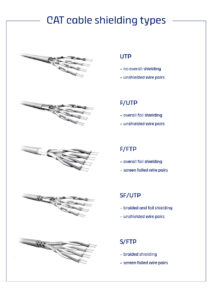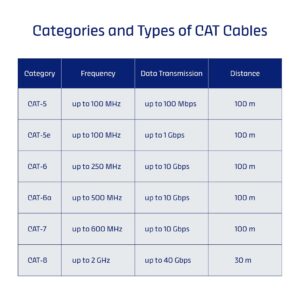Updated on 11/10/2023
CAT cables, also known as twisted pair cables, are used in all kinds of industries related to communications, telecommunications, and computer technology. Despite other cable types, they are still used as standard cables to transmit data. But what exactly are twisted pair cables? How are they built? And where are the differences between the different types of twisted pair cables? “Twisted pair cables: 6 questions – 6 answers” will give you an overview of the different cable variants and how they are used.
1. What are twisted pair cables?
The abbreviation CAT is short for category. It is therefore referring to different categories of cables that are suitable for different applications.
2. How are twisted pair cables built?
The strands of twisted pair cables consist of copper and are insulated. To prevent electromagnetic interference between the strands, two wire pairs are often shielded separately. Most twisted pair cables consist of four twisted wire pairs. To prevent crosstalk, the wire pairs are twisted to a different degree.
3. What are the different types of shielding for twisted pair cables?
Twisted pair cables are shielded in different ways:
UTP: Unshielded Twisted Pair: the wire pairs are not shielded
FTP: Foiled Twisted Pair: the wire pairs are shielded with aluminum
STP: Shielded Twisted Pair: the wire pairs are individually shielded and protected by a total shielding
The different types of shielding are often marked by the letters S, F or SF. These letters refer to supplementary materials within the cables.
S is short for braided shielding. The braid consists of copper and covers the wire pairs.
F is short for foil shielding meaning a shield consisting of metal or aluminum
SF refers to a combination of braid and foil
These supplementary materials are usually part of the UTP and FTP variants of CAT cables. Of course, these can also be combined.
4. What types of twisted pair cables are there?
There are different types of twisted pair cables that are divided into categories.
CAT 1-4: CAT1 to CAT4 versions were often used for telephone installations, ISDN connections as well as primary multiplex connections. However, these types of cables are rather unsuitable for modern systems since CAT5, CAT6 and CAT7 cables provide much better results when transmitting data.
CAT5: A CAT-5 cable supports operating frequencies of up to 100 MHz. Therefore, these cables are usually used for installing Ethernet networks.
CAT6: CAT-6 cables can manage operating frequencies of up to 250 MHz.
CAT7: The CAT-7 cable offers improved shielding. Operating frequencies of up to 600 MHz are possible with this type of cable. It is also suitable for 10 gigabit data transmission.
CAT-8: The high-performance CAT-8 cable is usable for data transmission up to 25Gbps or even 40Gbps. It supports operating frequencies of up to 2GHz.
5. How are twisted pair cables classified?
The performance of a cable is indicated, among other things, by its classification. For example, a CAT-6 cable has a maximum transmission speed and frequency that is comparatively lower than a CAT-6a cable. The latter offers improved shielding and support for 10 gigabit ethernet transmission over longer distances. The “a” stands for “augmented” here.
CAT 5e cables, for example, meet CAT 5 specifications but offer improved performance and bandwidth. They support data transmission rates of up to 1000 Mbit/s (1 Gbit/s). The “e” stands for “enhanced”.
The classification ranges from A to F.
And there’s even another distinction: the one between patch cables and installation cables. With patch cables, the conductors consist of several fine copper wires called strands. The flexible cable has a high attenuation. Compared to patch cables, installation cables consist of one wire. That’s why installation cables are not as flexible as patch cable and have a lower attenuation.
6. How are twisted pair cables used at G&D?
The use of CAT cables as a transport medium for the transmission of computer signals depends on the applications for which we are using them. Depending on the size of the signals and the length of the transmission path, the requirements vary. For our KVM installations, however, we use at least CAT-5e, which can transmit 1Gbit/s of data. Depending on the application and requirements, we also use fiber optic cables in addition to CAT cables.
Read more about the application areas of CAT and fiber cables and which aspects you should consider when planning a KVM installation in one of our next blog posts.
- Trade shows 2023: Experience G&D KVM products live and up close - 11. January 2023
- Innovative KVM solutions for control rooms - 14. December 2022
- Ada Lovelace – a true visionary and the world’s first female programmer - 12. December 2022


Thanks for sharing this great information.